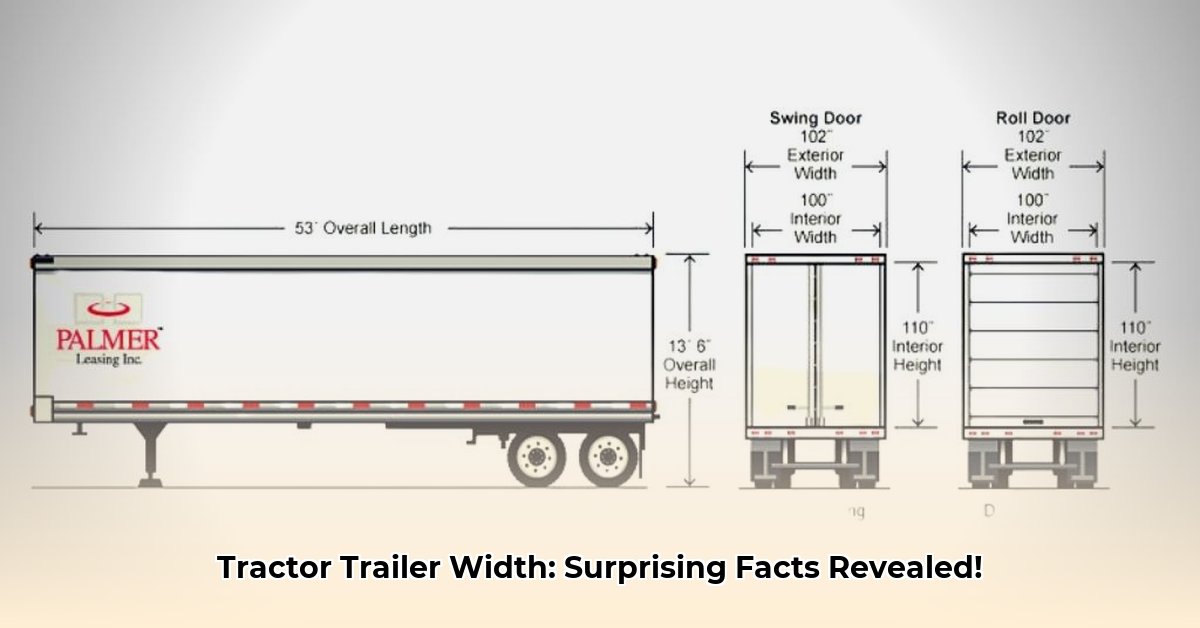
The typical width of a tractor-trailer is approximately 8.5 feet, but this doesn't include the side mirrors, which add roughly 10 inches on each side, bringing the total to approximately 10 feet. However, understanding the true width complexities requires delving deeper into the specifics of trailer types, federal and state regulations, and the real-world implications of exceeding these limits. For more detailed information on tire dimensions, check out this helpful resource: tire dimensions.
Decoding Tractor-Trailer Dimensions: Beyond the Basics
That seemingly simple 8.5-foot measurement only applies to the standard dry van trailer (a closed, box-like trailer). Other trailer types, such as flatbeds (open trailers for carrying larger cargo), tankers (for liquids or gases), and specialized trailers, vary significantly in their dimensions and require a more nuanced understanding. This variability directly impacts loading, transportation, and maneuverability, highlighting the importance of accurate pre-trip planning.
The Variety of Trailers and Their Impact on Width
Understanding the different trailer types is crucial. A dry van, the most common type, generally adheres to the 8.5-foot width. However, flatbeds can accommodate wider loads, potentially increasing the overall width. Tankers' widths change depending on their capacity and the material they carry. Specialized trailers are designed for specific cargo and therefore have even more varied dimensions. This diversity in trailer designs necessitates a careful consideration of width limitations for each type.
Navigating the Complexities of Federal and State Regulations
While federal regulations establish minimum standards, particularly concerning bridge clearances – usually around 13.5 feet in height – individual states often impose stricter rules regarding width, length, and weight. This creates a complex patchwork of regulations that impact both route planning and permit acquisition. Ignoring these state-specific regulations can lead to significant legal and logistical issues. For example, permitted length can differ greatly from state to state, affecting the planning of multi-state journeys.
Consequences of Non-Compliance: Fines, Accidents, and Route Restrictions
Failure to adhere to width, length, or height regulations results in significant consequences. These include hefty fines, increased risk of accidents, and potential delays caused by route restrictions imposed on oversized vehicles. The added costs of fuel consumption from detours, and potential damage to infrastructure, are also significant factors to consider. The potential financial and safety implications far outweigh any benefits from violating these regulations.
Practical Strategies for Safe and Efficient Transportation
For drivers and logistics professionals, adherence to regulations is paramount, and several strategies can improve safety and efficiency:
Invest in advanced route-planning software: These programs incorporate state-specific regulations, optimizing routes to avoid violations and delays.
Utilize real-time data: Traffic updates and weather reports provide situational awareness allowing for route adjustments in response to unforeseen circumstances.
Stay updated on regulatory changes: Regulations evolve, requiring ongoing vigilance to ensure compliance.
Ensure proper load securement: Improperly secured cargo can shift, altering dimensions and posing serious safety hazards.
Optimize load planning: Strategic planning minimizes the risk of exceeding weight or size limits and ensures efficient transportation.
A Quick Reference Guide to Common Trailer Dimensions (Approximate)
| Trailer Type | Typical Length (ft) | Width (ft) | Height (ft) |
|---|---|---|---|
| Dry Van | 53 | 8.5 | 13.5 |
| Flatbed | 53 | 8.5 | 13.5 |
| Tanker | Varies | Varies | Varies |
| Specialized | Varies | Varies | Varies |
Disclaimer: These dimensions are estimates. Actual measurements vary by manufacturer and specific trailer design. Always verify your vehicle's specifications and consult relevant state regulations.
Prioritizing Safety: The Overarching Goal
The focus on adhering to these regulations shouldn't just be about avoiding penalties; it’s fundamentally about safety. By understanding and respecting size and weight limits, drivers and logistics professionals protect themselves, other road users, and the infrastructure. Safe and compliant transportation practices are essential for the well-being of all involved. The seemingly simple question of "How wide is a tractor-trailer?" leads directly to a complex matrix of variables that must be accounted for, reinforcing the need for well-informed and careful planning.